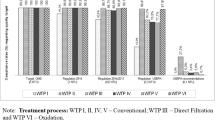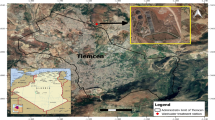Abstract
Water treatment plants (WTPs) are extremely important in basic sanitation services because of their association with human health by producing safe drinking water. Thus, their proper operation is of utmost relevance and has led to the development of distinct performance evaluation methodologies. Direct filtration is a leading technology applied in WTPs. However, although it costs less than conventional treatment, it might also be less flexible and robust. To evaluate performance with data from real-scale WTPs with direct filtration systems, the use of a statistical analysis methodology for turbidity, apparent color, and pH data from raw and effluent water is proposed. Reliability analysis, a probabilistic-based methodology, was applied for turbidity alongside evaluating the compliance of the treated water with different potability standards. The parameters pH (between 6.0 and 8.0) and apparent color (< 15 HU) showed almost complete compliance (> 99%). Reliability analysis could not be applied for apparent color and pH, while apparent color did not adhere to the lognormal distribution frequency. The turbidity results show high variability in the coefficients of variation and reliability among various plants and a general difficulty in complying with stricter standards, such as the 0.1 and 0.3 NTU defined by the United States Environmental Protection Agency. All WTP studies show a 95% compliance with the World Health Organization standard of 5.0 NTU. A higher value for the coefficient of reliability and a lower value for the variation coefficient could indicate a more stable process, regardless of the treated water quality, highlighting the relevance of applying combined methods for performance evaluation, such as compliance with established standards.








Similar content being viewed by others
Data availability
The datasets generated during and analyzed during the current study are not publicly available because of restrictions of privacy policies from local water treatment plant service providers. However, they are available from the corresponding author (L.D.V. Melo) on a reasonable request. These WTP service providers agreed to provide the dataset to the corresponding author under a disclosure agreement of not divulgating the provider’s names, operational parameters, geographical location, or other information that could identify each system.
Abbreviations
- COR:
-
Coefficient of reliability
- CV:
-
Coefficient of variation
- HU:
-
Hazen unit
- IQR:
-
Interquartile range
- NTU:
-
Nephelometric turbidity unit
- QMRA:
-
Quantitative microbial risk assessment
- USEPA:
-
United States Environmental Protection Agency
- WHO:
-
World Health Organization
- WTP:
-
Water treatment plant
References
Ahmadli Z, Fahiminia M, Ansari R et al (2017) Performance evaluation of Qom water treatment plant during 2005 to 2014. Arch Hyg Sci 6:58–65. https://doi.org/10.29252/ArchHygSci.6.1.58
Andreoli FC, Sabogal-Paz LP (2019) Coagulation, flocculation, dissolved air flotation and filtration in the removal of Giardia spp. and Cryptosporidium spp. from water supply. Environ Technol 40:654–663. https://doi.org/10.1080/09593330.2017.1400113
ANEXO XX da Portaria de Consolidação No. 5 do Ministério da Saúde de 5 de Outubro de 2017 (ANNEX XX of the Ministry of Health Consolidation Ordinance No. 5 of October 3, 2017 - Provides for the procedures for the control and surveillance of water quality for human consumption and its potability standard Source: PRT MS / GM 2914 / 2011), 2017. BRASIL, Ministério da Saúde, Diário Oficial da República da União, Brasília, DF. (in Portuguese)
Bichai F, Smeets PWMH (2013) Using QMRA-based regulation as a water quality management tool in the water security challenge: experience from the Netherlands and Australia. Water Res 47:7315–7326. https://doi.org/10.1016/j.watres.2013.09.062
Chhipi-Shrestha G, Rodriguez M, Sadiq R (2018) Unregulated disinfection By-products in drinking water in Quebec: a meta analysis. J Environ Manage 223:984–1000. https://doi.org/10.1016/j.jenvman.2018.06.082
Choudhury S, Saha AK (2018) Prediction of operation efficiency of water treatment plant with the help of multi-criteria decision-making. Water Conserv Sci Eng 3:79–90. https://doi.org/10.1007/s41101-017-0034-2
Chowdhury S (2013) Fusing probability density function into Dempster–Shafer theory of evidence for the evaluation of water treatment plant. Environ Monit Assess 185:3917–3929. https://doi.org/10.1007/s10661-012-2840-5
Di Bernardo L, Paz LPS (2008) Seleção de técnicas de tratamento de água. LDiBe, São Carlos, SP. (in Portuguese)
Gora SL, Andrews SA (2019) Removal of natural organic matter and disinfection byproduct precursors from drinking water using photocatalytically regenerable nanoscale adsorbents. Chemosphere 218:52–63. https://doi.org/10.1016/j.chemosphere.2018.11.102
Heller L, Pádua V L (2006) Abastecimento de água para consumo humano. Editora UFMG, Belo Horizonte, MG. (in Portuguese)
Levine DM, Berenson ML, Krehbiel TC (2005) Statistics for Managers Using Microsoft Excel. Prentice Hall, Upper Saddle River
Libânio M (2016) Fundamentos de qualidade da água. Átomo, Campinas, SP. (in Portuguese)
Ma B, Xue W, Hu C et al (2019) Characteristics of microplastic removal via coagulation and ultrafiltration during drinking water treatment. Chem Eng J 359:159–167. https://doi.org/10.1016/j.cej.2018.11.155
Maciel PMF, Sabogal-Paz LP (2016) Removal of Giardia spp. and Cryptosporidium spp. from water supply with high turbidity: analytical challenges and perspectives. J Water Health 14:369–378. https://doi.org/10.2166/wh.2015.227
Melo LV, de Oliveira MD, Libânio M, Oliveira SC (2015) Applicability of statistical tools for evaluation of water treatment plants. Desalin Water Treat 57:14024–14033. https://doi.org/10.1080/19443994.2015.1072586
Melo LDV, da Costa EP, Pinto CC et al (2019) Adequacy analysis of drinking water treatment technologies in regard to the parameter turbidity, considering the quality of natural waters treated by large-scale WTPs in Brazil. Environ Monit Assess 191:1–12. https://doi.org/10.1007/s10661-019-7526-9
Metcalf X, Eddy X (2003) Wastewater engineering: treatment, and reuse. McGraw-Hill Education, New York, NY
Nawaz S, Ali Y (2018) Factors affecting the performance of water treatment plants in Pakistan. Water Conserv Sci Eng 3:191–203. https://doi.org/10.1007/s41101-018-0051-9
Niku S, Schroeder ED (1981) Factors affecting effluent variability from activated sludge processes. J Water Pollut Control Fed 53:546–559
Niku S, Schroeder ED, Samaniego FJ (1979) Performance of activated sludge processes and reliability-based design. J Water Pollut Control Fed 41:2841–2857
Niku S, Schroeder ED, Tchobanoglous G, Samaniego FJ (1981) Performance of activated sludge process: reliability, stability and variability, EPA Grant no. R805097-01. Environmental Protection Agency, Washington D.C.
Niku S, Schroeder ED, Haugh RS (1982) Reliability and stability of trickling filter processes. J Water Pollut Control Fed 54:129–134
Novotna K, Cermakova L, Pivokonska L et al (2019) Microplastics in drinking water treatment – current knowledge and research needs. Sci Total Environ 667:730–740. https://doi.org/10.1016/j.scitotenv.2019.02.431
Oliveira SC, Von Sperling M (2007a) Análise da confiabilidade de estações de tratamento de esgotos. Eng Sanit Ambient 12:389–398. https://doi.org/10.1590/S1413-41522007000400005 (in Portuguese)
Oliveira SMAC, Von Sperling M (2007b) Reliability analysis of stabilisation pond systems. Water Sci Technol 55:127–134. https://doi.org/10.2166/wst.2007.343
Oliveira SC, Von Sperling M (2008) Reliability analysis of wastewater treatment plants. Water Res 42:1182–1194. https://doi.org/10.1016/j.watres.2007.09.001
Oliveira MD, Melo LDV, Queiroga LL, Oliveira SMAC, Libanio M (2014) Applying reliability analysis to evaluate water treatment plants. Water Sci Tech-W Sup 14:634–642. https://doi.org/10.2166/ws.2014.019
Padalkar AV, Kumar R (2018) Common effluent treatment plant (CETP): reliability analysis and performance evaluation. Water Sci. Eng 11:205–213. https://doi.org/10.1016/j.wse.2018.10.002
Prathna TC, Sharma SK, Kennedy M (2018) Nanoparticles in household level water treatment: an overview. Sep Purif Technol 199:260–270. https://doi.org/10.1016/j.seppur.2018.01.061
Resolução Normativa n.° 217 de 6 de Dezembro de 2017 (Normative Resolution No. 217 of December 6, 2017 - Establishes criteria for classification, according to size and pollution potential, as well as the location criteria to be used for the definition of the environmental licensing modalities of entreprises), 2017. MINAS GERAIS, Conselho Estadual de Política Ambiental/COPAM, Diário Oficial de Minas Gerais, Belo Horizonte, MG. (in Portuguese)
Shao S, Wang Y, Shi D et al (2018) Biofouling in ultrafiltration process for drinking water treatment and its control by chlorinated-water and pure water backwashing. Sci Total Environ 644:306–314. https://doi.org/10.1016/j.scitotenv.2018.06.220
Sistema Nacional de Informações Sobre Saneamento (SNIS) Secretaria Nacional de Saneamento Brasília (2019) Diagnóstico dos serviços de água e esgoto – 2018. http://www.snis.gov.br/diagnostico-anual-agua-e-esgotos/diagnostico-dos-servicos-de-agua-e-esgotos-2018. Accessed 22 Jan 2020. (in Portuguese)
Snedecor GW, Cochran WG (1989) Statistical Methods. Iowa State University Press, Ames, US
StatSoft (2011). Statistica 10.0
Su H-C, Liu Y-S, Pan C-G et al (2018) Persistence of antibiotic resistance genes and bacterial community changes in drinking water treatment system: from drinking water source to tap water. Sci Total Environ 616–617:453–461. https://doi.org/10.1016/j.scitotenv.2017.10.318
Teodosiu C, Gilca A-F, Barjoveanu G, Fiore S (2018) Emerging pollutants removal through advanced drinking water treatment: a review on processes and environmental performances assessment. J Clean Prod 197:1210–1221. https://doi.org/10.1016/j.jclepro.2018.06.247
United States Environmental Protection Agency/USEPA (2009) National Primary Drinking Water Regulations EPA 816-F-09-004, Washington D.C, US
Wang Y, Zhu G, Engel B (2019) Health risk assessment of trihalomethanes in water treatment plants in Jiangsu Province, China. Ecotoxicol Environ Saf 170:346–354. https://doi.org/10.1016/j.ecoenv.2018.12.004
World Health Organization/WHO (2011) Guidelines for Drinking-water Quality. Switzerland, Geneva. https://www.who.int/water_sanitation_health/publications/2011/dwq_guidelines/en/
World Health Organization (2017) Water quality and health - review of turbidity: information for regulators and water suppliers. https://apps.who.int/iris/handle/10665/254631
Zhang K, Achari G, Sadiq R, Langford CH, Dore MHI (2012) An integrated performance assessment framework for water treatment plants. Water Res 46:1673–1683. https://doi.org/10.1016/J.WATRES.2011.12.006
Acknowledgments
The authors would like to thank the Foundation of Support and Research of the State of Minas Gerais (FAPEMIG), the Coordination of Superior Level Staff Improvement (CAPES), and the National Council for Scientific and Technological Development (CNPq) for their support during the research. We would like to thank Editage (www.editage.com) for English language editing.
Funding
This work was supported by the Foundation of Support and Research of the State of Minas Gerais (FAPEMIG), the Coordination of Superior Level Staff Improvement (CAPES), and the National Council for Scientific and Technological Development (CNPq). The funding sources were not involved in the study design, the collection, analysis, and interpretation of data, the writing of the report, or the decision to submit the article for publication.
Author information
Authors and Affiliations
Contributions
Study conception and design: L.D.V. Melo, G.R. Barroso, and S.C. Oliveira; dataset organization and statistical analysis execution: L.D.V. Melo, G.R. Barroso, and R.S. Figueiredo; interpretation of results, manuscript writing, and revision: L.D.V. Melo, G.R. Barroso, R.S. Figueiredo, and E.P. Costa. All authors read and approved the final manuscript.
Corresponding author
Ethics declarations
Ethics approval and consent to participate
Not applicable.
Consent for publication
Not applicable.
Conflict of interest
The authors declare that they have no conflicts of interest.
Code availability
Not applicable.
Additional information
Responsible Editor: Philippe Garrigues
Publisher’s note
Springer Nature remains neutral with regard to jurisdictional claims in published maps and institutional affiliations.
Supplementary information
ESM 1
(DOCX 61 kb)
Rights and permissions
About this article
Cite this article
Melo, L.D.V., Barroso, G.R., Figueiredo, R.S. et al. Applicability of statistical analysis for performance and reliability evaluation of large-scale water treatment plants with direct filtration systems. Environ Sci Pollut Res 28, 22427–22438 (2021). https://doi.org/10.1007/s11356-020-12288-5
Received:
Accepted:
Published:
Issue Date:
DOI: https://doi.org/10.1007/s11356-020-12288-5




